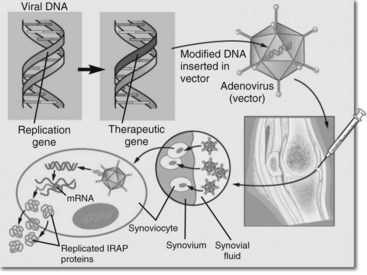Chapter 63Gene Therapy
Review of Components of Gene Therapy
There are two potential methods of gene transfer. Ex vivo gene transfer is an indirect technique where the cells are collected from the joint and grown in the laboratory (e.g., synovial cells). The gene is then transferred (transduced) into cultured cells using a viral vector, and the transduced cells are reimplanted after testing for protein production. Ex vivo transfer is safer but less convenient than the second technique, in vivo transfer. In vivo transfer involves direct transfer of a vector to the target tissues. For example, synovial cells could be transfected by direct transmission of an IL-1ra gene using an adenovirus vector injected into a joint (Figure 63-1). Adenoviruses are the most common vectors proposed for use in human patients with clinical disease2 and were used in our equine studies.3-9 Adenoviral vectors can transduce dividing and nondividing cells and are amenable to in vivo transfer. The adenoviral vector takes up an episomal location (extrachromosomal) in the host nucleus. Second-generation vectors give protein expression for 21 to 40 days.




